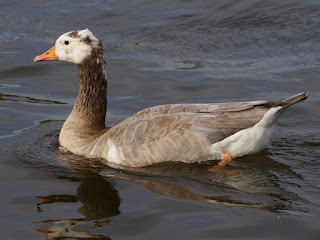The first Shovellers have returned, rather early this year. There were three on the Long Water. This is an immature drake.
There has also been an arrival of about 30 Pochards, mostly male. The sexes migrate separately, drakes first.
About the same number of Red-Crested Pochards were on the Long Water. But these are not migrants: they come in from Regent's Park at any time, and go back again as they please.
There is some kind of swimming event on the Serpentine which has caused a big disturbance. It brought the Canada--Bar-Headed hybrid goose over to the south shore.
The adult Great Crested Grebes are not bothered by human swimmers -- they can do this so much better. They are fading into their plain winter plumage.
They are also moulting their flight feathers, which in those that have bred have been damaged by being used as a playpen for the chicks. They will be able to fly again by the time frosty weather is possible, so they can move to the river if they need to, The young ones will also be airworthy by then (as far as a Great Crested Grebe is -- flight is not really their thing).
The Moorhens in the Dell were building a fifth nest.
But the poor young Grey Heron, still with the bit of plastic stuck to its bill, hungry and angry, came over and stamped it to bits.
It seems that it will have to wait until it is too weak to escape, and then Malcolm will get the plastic off and it may pull through. At least it can drink, and was doing so while I watched.
A visit to the Rose Garden revealed nothing but a Robin in a rose bush, ticking irritably at the weekend crowds.
Two young Wood Pigeons in the leaf yard were idly hassling a parent on a branch.
The female Little Owl was in the nest tree.
Three Jackdaws arrived and perched challengingly near, but she took no notice and after a while they flew away.
The white-faced Blackbird near the Italian Garden looked at me quizzically before coming out for a bit of biscuit.












Hi Ralph,
ReplyDeleteThose three scuffling birds look more like young Woodpigeons than Stock Doves.
Regards,
Alex
I thought so too, but looked at their eyes through binoculars and they were dark.
DeleteYoung woodpigeons do have dark eyes and the white wing edge on nearest two birds shows they are woodpigeons, some of white cheek patch just visible on centre bird being hassled for vomit by 2 juvs. Just testing weren't you, Ralph? ;) Jim
DeleteOh, all right then. Changed.
DeleteN.B. I meant that the middle one is an adult, parent, thanks. Jim
DeletePoor heron.
ReplyDeleteI am almost praying for the poor Heron to weaken as fast as possible. I am sure that Malcolm will do everything in his power. It is very distressing, though, and I can only imagine that it must be doubly so for Ralph and all the friends who visit the park.
DeleteIt is dreadful to watch, as the bird keeps ineffectually trying to shake off the tangle of plastic.
DeleteDid you see the bird fly today? I think it's gone three days without food; it can't hold out much longer. Perhaps it's a matter of hours before Malcolm can catch it.
DeleteIt's been in the Dell for more than a day now. But it's still moving around briskly on foot.
DeleteHow long can he go without food?
DeleteNo idea. But if he shows signs of incipient collapse I will ring Malcolm at once.
DeleteI was wondering if a licenced bird ringer might be able to help the young heron?
ReplyDeleteMalcolm has as much experience of catching birds as any ringer, and knows the ground.
DeleteThat's good to know - if anyone can help, he sounds best placed. Fingers crossed for a positive outcome.
ReplyDeleteYour Shoveler photo looks like a juvenile drake to me. Good to know they are back.
ReplyDeleteThanks. You're right, of course. Careless of me.
DeleteI notice (on Wiki) that a black swan has appeared at the London Wetland Centre. I don't suppose it could be you-know-who, by any chance?
ReplyDeleteJanet N.
Hope that someone can get close enough to it. NB there are two captive Blacks Swans at the Wetland Centre, but these would not be reported on the Wiki.
Delete